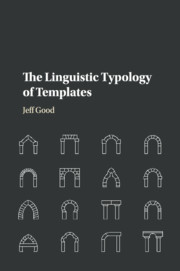Book contents
- Frontmatter
- Contents
- List of figures
- List of tables
- Acknowledgments
- Glossing abbreviations
- 1 Defining template
- 2 A typological description language for templates
- 3 Typologizing templates: case studies
- 4 Typologizing templates: comparison
- 5 Moving forward
- Appendix Specification of template description language
- References
- Author index
- Author index
- Term index
1 - Defining template
Published online by Cambridge University Press: 05 February 2016
- Frontmatter
- Contents
- List of figures
- List of tables
- Acknowledgments
- Glossing abbreviations
- 1 Defining template
- 2 A typological description language for templates
- 3 Typologizing templates: case studies
- 4 Typologizing templates: comparison
- 5 Moving forward
- Appendix Specification of template description language
- References
- Author index
- Author index
- Term index
Summary
Templates: often invoked, but undertheorized
The notion of a template has been used in a number of linguistic domains to refer to grammatical patterns where the form of some linguistic constituent appears to be well conceptualized as consisting of a fixed linear structure, whether in terms of the arrangement of its subconstituents or its overall length. To take two examples, consider Table 1.1, which schematizes the ordering of morphemes in verbs across the Athabaskan family, and Table 1.2, which gives data illustrating the application of a particular nickname formation strategy in Japanese where the resulting nicknames must be bimoraic in length.
The pan-Athabaskan template described in Table 1.1 characterizes verbs in this family as consisting of a series of “slots” into which morphemes of different grammatically defined classes appear. Hoijer (1971) did not explicitly use the word template to characterize his analysis, though this term is often found in the Athabaskanist literature to describe the verbal system (see, e.g., Rice (2000: 9)). Section 1.3 will discuss, in detail, the issue of how we might rigorously define template, but at this point, it will be sufficient to say that the crucial feature of Hoijer's analysis which prompts the application of the label is that the linear order of these verbal morphemes is treated as grammatically stipulated rather than deriving from some general principle. As such, the use of the term seems to be an extension of its informal use as referring to a device which sets a pattern on the basis of which objects of a given kind can be constructed.
Poser (1990: 81) does explicitly use the word template to describe the pattern exemplified in Table 1.2, wherein a full name participating in this nickname construction in Japanese must be realized as bimoraic either via truncation of a longer name (e.g., hanako → hana-) or lengthening of a shorter name (e.g., ti → tii-), among other possibilities (see Mester (1990) for additional discussion of the templatic properties of Japanese nicknames). What makes this pattern templatic is the fact that a particular morphological constituent must be of a specific length regardless of what its length would be expected to be on the basis of its lexical segmental specification.
- Type
- Chapter
- Information
- The Linguistic Typology of Templates , pp. 1 - 39Publisher: Cambridge University PressPrint publication year: 2016

